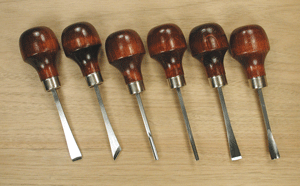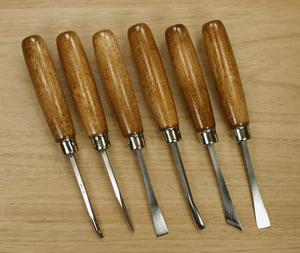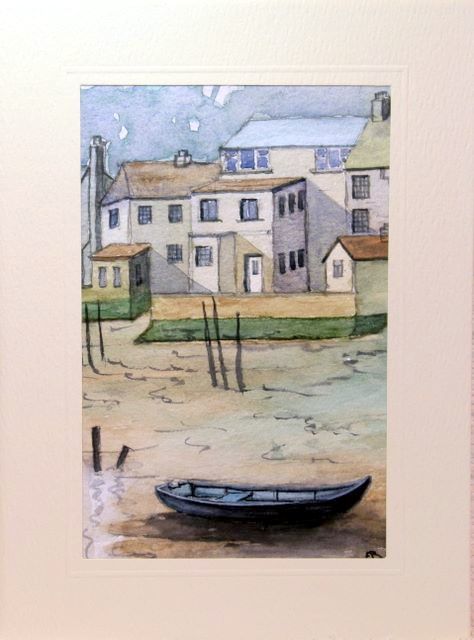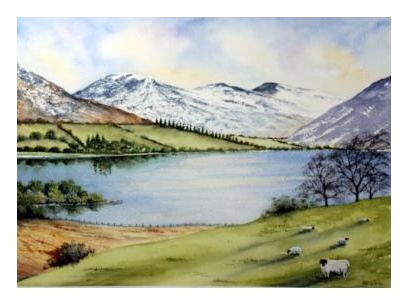Wood Carving Tips for Beginners
Wood Carving is, for many people, an
interesting combination of hobby and
art. Here are a few tips that will
help beginning wood carvers learn
how to master this rewarding hobby:
Tip1:
Ask questions! There is absolutely
no shame in wanting to learn
something, and experienced wood
carvers will always have a useful
tip or instruction for you. Before
you can develop your personal
carving style you need to learn the
basics, so joining some classes or
having a tutor may just be one of
the best approaches.
Basic Carving Set
with Palm Style & Long Style Handles
Tip 2:
Don’t rush. There is no point in
finishing a carving quickly. You
should work without any time
pressure and without attempting to
produce something beautiful very
quickly. Communicate with the wood
while you are carving and create a
comfortable pace for your work –
this is the only way in which you
can produce harmonious results. When
it comes to wood carving, patience
is a virtue!
Tip 3:
Safety is essential. You are working
with a wood carving knife and accidents
are always a potential danger. Make sure
to get used to holding the knife firmly
and learn how to handle the wood itself.
Always keep your other hand out of the
way of the carving knife and wear a
thumb guard on the carving hand. Thumb
guards might take a while to get
accustomed to, but they offer excellent
protection against knife cuts.
Tip 4:
Analyze your work. Compare your wood
carvings with those of others, both
professional and amateur. Do not do this
in a competitive fashion – instead, try
to adopt ideas and perspectives noticed
in other wood carvings and adapt them to
your own style.
Tip 5:
Work smart. Don’t work on the
carving for more than 30 – 45
minutes at a time. Your hands will
get cramps from the work unless you
are trained to do this. Don’t turn
wood carving into an unpleasant and
demanding experience. Valuable
results are achieved in time, not in
one afternoon!
Safety
Remember, you are using a sharp
knife while carving, which could
cause serious injuries if not
handled properly. This may seem
trivial, but accidents happen. It is
a good idea to keep bandages on
hand. Also, take your time while
carving. Haphazardly working as fast
as you can may cause problems.
How to handle a knife
Use your wrist while carving and not
your elbow. You will have more
control taking smaller pieces of
wood off than trying to remove large
chunks and sending the blade through
the air. Keep the blade sharp, the
duller the knife the more you have
to dig into your wood. Also, always
cut down and not across. Turn the
wood while pressing down so that
when you get to the side of your
wood, the knife stays on your wood
doesn't slip off. Don’t use the
knife as a scraper; this would dull
the edge of the blade. And don’t pry
any wood off; this would break the
tip of the blade.
Pencil it in
Draw a centre line down the middle
of the wood to help you keep both
sides balanced. Use a pencil to draw
out your idea on the wood before you
cut. It’s much easier to erase a
pencil mark than a deep cut or an
undesirable cut away wood. Not only
will a pencil help you in your
creativity, but also a pencil will
help you from making big mistakes.
Types of wood
There are numerous kinds of wood to
carve, but basswood is a good
starter. If you plan not to paint
your work and want to show nice
grain, you may want to choose
Butternut. Another nice carving
wood, but one that is a little more
expensive, is Tupelo.
Watch the grain
Determine which direction the grain
is running. You will want your
carving cuts to go with the grain.
(Practice making a few cuts on a
scrap of wood) Like using a
spoon to scoop out melon balls,
slice into the wood and come up and
out at the end of the slice. If you
do not cut out at the end of the
cut, the wood may rip or tear. Your
cuts may be short or long, as long
as you do not tear away the wood.
If the wood chip does not drop off
by itself it is not cut all the way.
Do not pull off chips as this may
tear the wood.
Do not be discouraged
If your first carving does not come
out the way you wanted, don’t be
discouraged and quit carving. This is a
new hobby for which will take time and
practice to master. Learn from your
mistakes and apply that learning to the
next carving.
|








